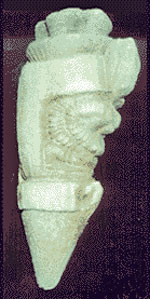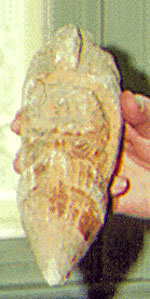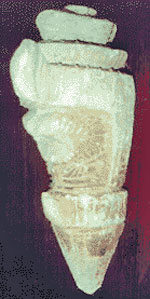|

by Laura Lee
from
LauraLee Website
  
Is this a replica (see photo) of an
ancient single-seat rocket-ship? That’s what it looks like to
Zecharia Sitchin, the leading authority and scholar on the
Ancient Astronaut theory. Hidden away in the Istanbul Archaeology
Museum in Turkey for a quarter of a century, Sitchin recently
convinced the Museum that this artifact may indeed be ancient, and
not the modern forgery they concluded it must be, simply
because our current view of our ancient history doesn’t include
rocket-ships.
In his article in Atlantis Rising Magazine, Issue 15,
Sitchin describes this object as,
"a sculpted scale model of what, to
modern eyes, looks like a cone-nosed rocket-ship… Powered by a
cluster of four exhaust engines in the back surrounding a larger
exhaust engine, the rocket-ship has room for a sole
pilot—actually shown and included in the sculpture."
He describes the pilot as sitting with
legs folded toward his chest, and wearing a one-piece "ribbed
pressure suit" which becomes boots at the feet, and gloves at the
hands, and points out that since the pilot’s head is missing, we
cannot know whether the pilot wore a helmet, goggles, or other
headgear. The artifact measures 23 centimeters long, 9.5 cm high, 8
cm wide, or 5.7 inches long, 3.8 inches high, and 3.5 inches wide.
Sitchin spent years tracking down the artifact, until he
located it at the Archaeology Museum in Istanbul. It was
excavated at Toprakkale, a city known in ancient times as
Tuspa, where the kingdom of Urartu reigned briefly over
2500 years ago. The museum curators decided this small artifact must
be a forgery because it differs from the era’s style, and more
importantly, it looks like a space capsule. They reasoned
that since there were no space capsules in ancient times, it must be
a modern fake, a practical joke, made of
plaster of Paris and marble powder.
However, during Sitchin’s visit to Istanbul and the Museum in
September 1997, he met with the Director, Dr. Pasinli,
who took the artifact from a drawer, and allowed Sitchin to examine
and photograph it. It looked to Sitchin to be carved from a porous,
volcanic ash stone, the details very precise. Dr. Pasinli
asked Sitchin what he thought. It is not out of context,
Sitchin told the Director and his colleagues, when you view
various artifacts that also seem to represent an ancient, space
faring civilization.
In Sitchin’s "The Lost Realms," you’ll
find illustrations of artifacts that may represent bearded spacemen
and rocket-ships from Mexico, and from Lebanon, what
might be a rocket-ship on a landing platform. He advised the Museum
directors to allow viewers to decide for themselves what it is,
while stating their own doubt about the artifact’s authenticity.
This was enough to convince the curators to finally put the object
on public display. Be sure to have a look for yourself next time you
are in Istanbul.
|



